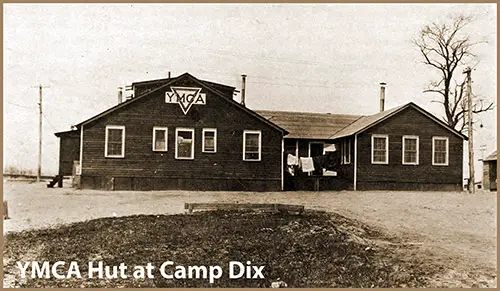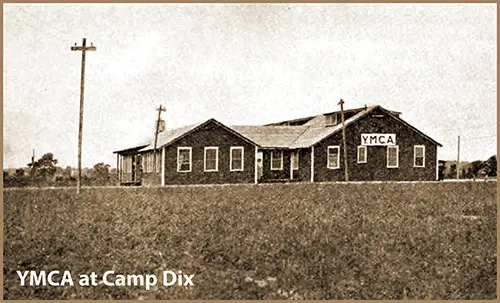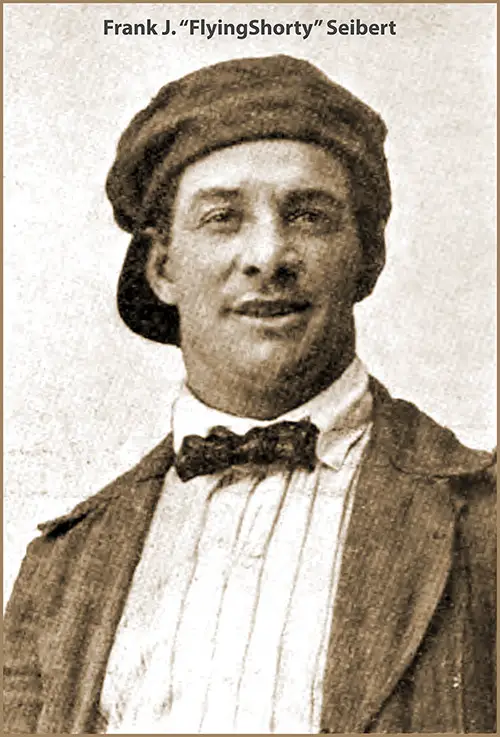The YMCA Hut at Camp Dix

A YMCA Hut at Camp Dix. Camp Dix Described and Photographed by Roger Bathelder, 1918. GGA Image ID # 1cea461984
THE YMCA THE "Red Triangle" of the YMCA has become a byword in America since the first draft men were called to the colors. Before that time, the Association's activities among the soldiers were little known or appreciated outside of military circles. Even now, the civilian has no conception of the great work of the Y. men or the extent of their operations.
The purpose of the YMCA is to place a hut or tent for rest and recreation with every large unit of the American army, whether at home or overseas.
In June 1917, when the draft cantonments' project was first made public, the YMCA conferred with the authorities and planned to build several huts at each of the camps.
When the draft men arrived in September, the huts were so crowded that additional buildings and equipment were necessary. The successful campaign of the fall of 1917 assured the workers of adequate funds, and since that time, no expense has been spared in completing the great work.
At Camp Dix, the YMCA has a hut in every large unit and a grand auditorium for shows, popular lectures, and entertainments, for which the individual hut would not be large enough. The building in the picture shows the standard type of Y. building at the cantonment.
The interior is furnished with chairs, writing benches, musical instruments, and has a stage for the local shows and wrestling matches. Attend ants are always in charge, ready to help the boys in any way possible. Writing materials are distributed free, and one may obtain stamps and cards at the desk.
The entertainments given at the huts are usually amateur; the fun is furnished by the "local talent" of the nearby companies. Sometimes there are movies, boxing, and wrestling matches.
Sunday is the only day on which any religious activities are held. The services are made as attractive as possible to the soldiers, and frequently "big men" from the cities come to the huts and give a "straight from the shoulder" talk.
Y. M. C. A. Work at Camp Dix

The Camp Dix YMCA Building. The Camp Dix News, 25 August 1917, p. 25. GGA Image ID # 1ce9ebe5f1
By Olof Gates
Y. M. C. A. work at Camp Dix is being conducted under the National War Work Council of the Young Men’s Christian Associations of the United States, with headquarters at New York—from which all the Y. M. C. A. work throughout the world is being conducted.
Nine regular buildings with capacity for seating about 1,000 men each, an auditorium seating 3,200 and an administration building are rapidly being erected. Two of the buildings are completed, and the others well under way.
While the original intention was to use the building only for the men of the National Army, there was such a great need for the men now erecting the cantonment that the Association placed its first building at the disposal of the men. Whether or not it has been appreciated can be easily seen from a visit any night.
There is an abundance of writing materials—always to be bad for the asking—and last week from the building alone nearly two thousand letters were mailed.
Religious services are conducted on Sunday, opening with Catholic Mass at 9 A. M., Protestant service at 10.30 A. M., and a vesper service, which is a song service, at the close of the day.
There is usually something doing each night at the building, and 800 to 900 men are on hand to hear and see.
Some of the recent entertainments have been a Minstrel show by the Boys' Club from Burlington; band concert by Fifteenth Regiment Band; sailors’ quartet from New York; James Heron and singer from New York; buck and wing contests, and almost each night for the next few weeks has been booked for some program.
In addition to the building a tent has been in operation almost since the first few men came to Wrightstown. This is near the Employment Office and Camp Dix Railroad Station. It is used to its capacity, and, judging from the way the men use it, a need is being filled.
With the arrival of the Fifteenth Colored Infantry from New York-the Association immediately erected another tent, and within a few hours had two trained colored secretaries ready to meet the needs of the men.
It has been impossible to operate the motion-picture machine, due to the apparatus not being suited to the temporary electric plant but as soon as Public Service is installed a show will probably be given four times a week.
Each one of the nine buildings will be manned by five secretaries, and, with the five at headquarters staff will constitute a group of fifty men.
Herbert P. Lansdale, General Secretary of the Rochester, N. Y., Y. M. C. A., will be the Camp General Secretary on the arrival of the National Army, and a number of business men are volunteering their services for the period of the war, so that while there will be over fifty Y. M. C. A. men on the staff, a large majority of them will be business men who are giving their services without charge.

Frank J. Seibert -- "Flying Shorty." The Camp Dix News, 25 August 1917, p. 3. | GGA Image ID # 1cea30f7ff
Olof Gates, formerly General Secretary of the Elizabeth, N. J., Association, is in charge of the work at present, and is now giving his special attention to the construction work being done by the Association.
Requests have come from a number of men for some short-term classes in French and other subjects. The Association is ready to start classes as soon as there is a sufficient demand, and if any one is interested in a special course, ask about it at the Y. M. C. A. building or any of the tents.
Basketball, volleyball, baseball, medicine-ball, are some of the sports the Association is ready to promote as the demands require.
The building and tent are open to all men working on the cantonment, and you are welcome to use any of the privileges the Association has to offer.
If you can perform, play, sing or do something worth while and entertaining, tell some of the secretaries about it, as in this community where we are all living each fellow must do something for the other. That is what makes it worth working for.
Frank J. Seibert, of Pittsburgh, better known as “Shorty,” has recently been made a despatcher for General Superintendent Lynch.
A former balloonist, jockey entertainer and moving picture actor, the Camp prefers to know him as a speed artist, whether he is in the saddle of a motorcycle or at the wheel of an “eight-eighty.”
We warn the members of the Camp that when they see a streak shooting over the field that it is “Shorty” on his motorcycle in an effort to break all speed records.
Olof Gates, "Y. M. C. A. Work at Camp Dix," in The Camp Dix News, 25 August 1917, p. 3.
